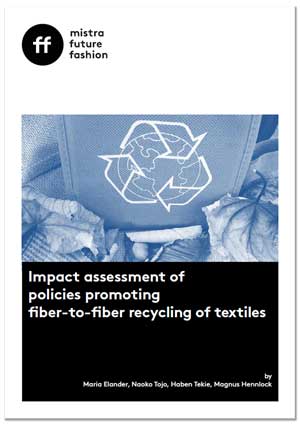A new report shows that mandatory Extended Producer Responsibility (EPR) and a Refunded Virgin Payments system (charge on virgin fibers) have large positive impacts on fiber-to-fiber recycling as well as overall recycling of textiles. Researchers see need to broaden the scope regarding potential policy measure, both upstream and downstream improvements achievable with the right scope and design of a mandatory EPR. A system for refunded virgin payments would contribute to closing the loop for textiles.

Read the short abstract version of the report here.
Read the full report here.
Stockholm, June 30th, 2017. Mistra Future Fashion presents a new report “impact assessment of policies promoting fiber-to-fiber recycling of textiles”, conducted by the research partners IVL Swedish Environmental Research Institute (IVL), International Institute for Industrial Environmental Economics (IIIEE) and PlanMiljø. A mandatory extended producer responsibility (EPR) for textiles and a refunded virgin payments (RVP) system are assessed in regard of the Swedish context and the Swedish fashion industry. Both policy measures show large positive impacts on promoting fiber-to-fiber recycling of textiles and contributing to circular flows of textile waste. The report presents a comprehensive assessment of how the two policies contribute to eight policy goals. In EPR producers bear responsibility for the environmental impacts of their products throughout the product life-cycle. RVP is a two-way measure with producer charges for virgin fiber usage and refunds based on use of recycled textile fibers.
The findings from the report aim to broaden the current discussion and scope regarding potential policy measures in the textile field. The Swedish Environmental Protection Agency suggests a mandatory EPR for textiles as one of two alternative policy options for handling of textile waste (Sept 2016). However, the proposal focuses almost exclusively on downstream improvements. The researchers call for inclusion of additional elements in a mandatory EPR for textiles, embracing also the potential of an EPR system to generate upstream improvements such as design, production and usage requirements and contribute to increasing the demand for recycled textile fibers.
The impact assessment has been was carried out regarding expected outcomes related to the following eight policy goals: 1) increased collection of used textile products (post-consumer textiles), 2)increased reuse of used textile products, 3)increased overall recycling of used textile products, 4) increased fiber-to-fiber recycling of used textile products, 5) prevention of hazardous / unwanted chemicals, 6) development of technologies for sorting and (fiber-to-fiber) recycling of textiles, 7) increased transparency of material flows, 8)improved design for fiber-to-fiber recycling.
A mandatory EPR system has the same or larger positive impacts on all eight policy goals defined in this report compared to a RVP system. A mandatory EPR system embodies the potential to integrate a range (combination) of complementing policy measures whereas an RVP system should be complemented by additional policy measures.
For more information:
Maria Elander, IVL Swedish Environmental Research Institute, +46 10788 66 56, maria.elander@ivl.se
Sigrid Barnekow, Mistra Future Fashion, +46 703955468, sigrid.barnekow@mistrafuturefashion.com



